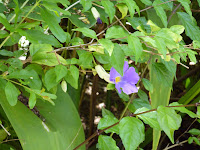FOOD AND
GARDENS
For
people with a hankering for a bit of luxury in their life and with pockets deep
enough to accommodate it, the west coast of Barbados is the place to be. Hotels here hog the seafront and can seem a
bit ‘over exclusive’ for the everyday visitor.
But not a bit of it. A little
known fact is that there are no private beaches in Barbados. Beaches are for everyone to enjoy and access
paths can be found all along the coast road.
With a bit of research though, you can add a bit of luxury to the
experience. Many hotels are open for
breakfast, lunch or dinner – and with just a little advance booking you can
combine a garden visit with great food and relaxing on the beach.
LUNCH AT THE
COLONY CLUB
There’s
a wonderful Bajan tradition called the buffet lunch. It’s an ‘all you can eat’ affair and for the
equivalent of between £20 and £40, the food is plentiful and delicious. I’ve indulged in (or pigged out on) quite a
few over the years, but this year I decided that The Colony Club was worth a
try and booked ahead. I can say, without
reservation, that this buffet was particularly exceptional. Fresh fish, salads, beef, ham, lamb stew,
vegetables, grilled fish to order followed by a selection of deserts stacked up
to at least five courses. The elegant
surroundings ,brilliant service and the steel band added to the ambiance of the
occasion and after eating to a standstill, there was little else I could do but
stagger a few yards to the beach for a lie
down. Beach-bedside drinks service until
sunset made the afternoon complete or, should I say, replete.
 However,
gastronomy aside, the gardens here were a real surprise. Winding paths through lush tropical planting made
the grounds feel more like a garden than a hotel so, needless to say, I wanted
to find out more and booked myself onto one of the weekly garden tours.
However,
gastronomy aside, the gardens here were a real surprise. Winding paths through lush tropical planting made
the grounds feel more like a garden than a hotel so, needless to say, I wanted
to find out more and booked myself onto one of the weekly garden tours.  After
setting the scene with a bit of history about the hotel, head gardener Sandra
showed us round. Within minutes it was
obvious that her plant knowledge was exceptional and she was pleased to answer
all my questions on familiar and less familiar tropical plants.
After
setting the scene with a bit of history about the hotel, head gardener Sandra
showed us round. Within minutes it was
obvious that her plant knowledge was exceptional and she was pleased to answer
all my questions on familiar and less familiar tropical plants.  The gardens are a horticulturalist’s dream
from the trees, some of which had been there for decades and set the scene for the
planting, to the myriad of palms, shrubs and ground cover plants which were all
planted sympathetically and informally around the various guest buildings and
pools dotted around and through the gardens.
The gardens are a horticulturalist’s dream
from the trees, some of which had been there for decades and set the scene for the
planting, to the myriad of palms, shrubs and ground cover plants which were all
planted sympathetically and informally around the various guest buildings and
pools dotted around and through the gardens.
Highlights for me were the mass
planting of Philodendron under an ancient evergreen tree which gave it bags of
atmosphere.
Travellers Palms planted
either side of a path forming an archway of architectural foliage.
Some
wonderfully unusual ginger lilies.
The waterfall surrounded by ferns.
And, finally, the
most incredible blue water lily in a formal pond.
I came away with a comprehensive plant list,
an increased knowledge of tropical plants and a burning envy of Sandra who comes
here to work every day.
You can also book for breakfast and dinner but come before sunset to enjoy the gardens – look out for jazz nights too.
Colony
Club Hotel, Folkestone,
St James








































